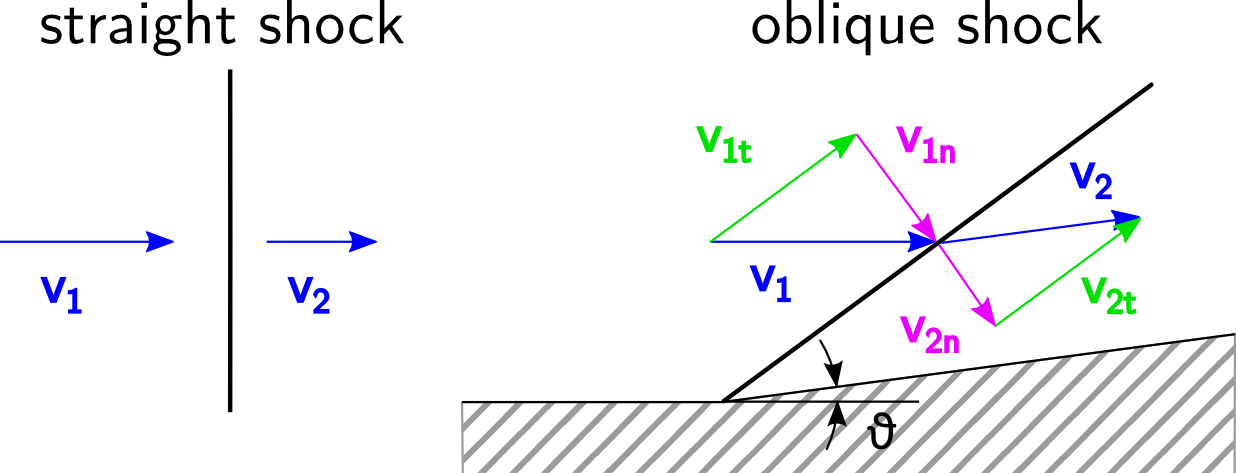Wherever I read about shock waves, it is mentioned that there is a reduction in speed across the shock wave.
Can someone please explain what happens at the molecular level, i.e. the physics of the problem?
Wherever I read about shock waves, it is mentioned that there is a reduction in speed across the shock wave.
Can someone please explain what happens at the molecular level, i.e. the physics of the problem?
If you look what causes the shock, there must be an obstruction at the root of it. See the sketch below for a straight and an oblique compression shock:

In case of the straight shock this can be a blunt body or an intake filled with slower moving air of higher pressure. In case of the oblique shock this is clearly the bend in the wall contour which forces the flow to change direction.
The index 1 denotes conditions ahead of the shock, and 2 those downstream of the shock. For weak straight shocks the product of the speed ahead of the shock $v_1$ and the speed past the shock $v_2$ equals the square of the speed of sound: $$v_1\cdot v_2 = a^2$$ If we call the local Mach number $Ma$, and if $Ma_1 > 1$, then $Ma_2$ must be smaller than 1, so the flow is always decelerated to subsonic speed by a straight shock. The same holds for the normal component of an oblique shock: It also becomes subsonic. Since the total energy of the gas doesn't change, its pressure, density and temperature rise when it is decelerated.
The incremental pressure change $\delta p$ due to the bend with an incremental angle of $\delta\vartheta$, expressed in terms of the undisturbed flow with the index $\infty$, is proportional to the change in the streamlines: $$\delta p = -\frac{\rho_{\infty}\cdot v^2_{\infty}}{\sqrt{Ma^2_{\infty} - 1}}\cdot\delta\vartheta$$
Gas pressure on a molecular level is the number and severity of particle collisions. The air molecules experience more collisions on the downstream side of the shock, since air pressure is higher there. The average direction of the additional collisions is indeed orthogonal to the shock, because it is the boundary between blissfully unaware molecules at ambient pressure ahead of the shock and their bruised brethren downstream which have just crossed that boundary. Once a molecule has passed the shock, the collisions are coming again equally from all sides and its speed does not change any more.
In subsonic speeds this pressure change can radiate in all directions and becomes a shallow pressure gradient. In supersonic speed, no information about the upcoming pressure change can travel forward, so the change is concentrated in the shock front.
The mechanism is not as complicated as might seem in a first glance. First thing, what's a supersonic flow? Is a flow where the speed of the air is higher that Mach > 1 and if we are talking about air that is coming from an upstream subsonic flow the air will be at lower pressure (that is what is happening on the upper surface of a wing).
So, high speed air with low pressure that tries to move along the wing up to the end of the wing (the trailing edge), but at the end of the wing the air is at the upstream subsonic pressure... so, air at a higher presure usually tries to go into low pressure air... but the supersonic air has a lot of inertia.
Finally we end up having air of high speed very difficult to stop... we are talking about very high speeds and the only way the air can adapt is in a very small space with a shock wave.
That is the mechanism that is called "shock wave in adverse pressure gradient".
There is another mechanism that has been described above, supersonic flow agaisnt obstacles.
Imagine that we have a supersonic flow moving towards a step, or a ramp... obviously the air has again the same high inertia, is supersonic!!! But the air "does not know" that there is a ramp. Why not? Because the information within fluid moves at the speed of sound, the molecules of the air that bound of the ramp are not able to reach fast enough the other molecules fast enough.
So... a high inertia flow moves towards a ramp and suddently notices a ramp that the flow was not adapting before and needs to adapt!!! So does it suddently in a very similar way as before.
Another way to understand the mechanism is by looking at the waves that are created when we throw a stone into water. What happens when they approach to the shore? They continue as there is no shore until, suddently they notice it and they die or bound on it. Is the same mechanism (actually the same!!! supersonic moves in "waves").
Finally, just to remark that shock wave has a finite size, is really small but is not a 0 thickness surface. Notice that we have an area where a high speed is transformed into low speed in a very small space. There the viscosity plays some effect.